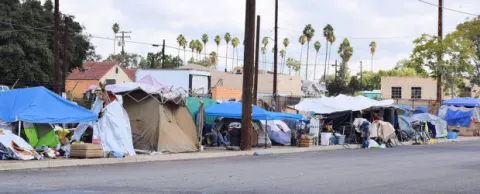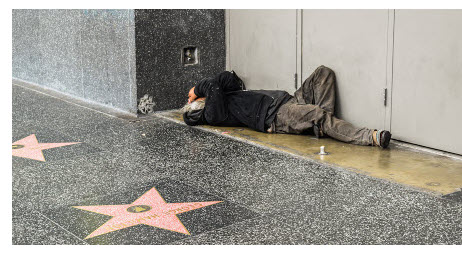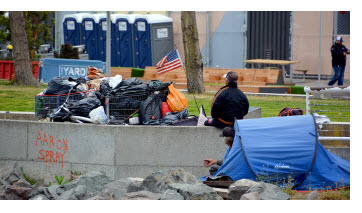
I would guess one of the most daunting challenges city leaders and human services providers have on their plates today is how to help the homeless in their communities and at the same time protect public health and safety. In the case of homeless encampments, I'm not sure we've seen a one-size-fits-all solution. But we are seeing a lot of different approaches, as you'll read below. – Philip Bane
A Los Angeles Times report found that a $14 million citywide cleanup of homeless camps has made only a marginal difference in the number of encampments since it launched in 2015. Meanwhile, there are 18% more homeless people living on city streets this year.
While some suggest that cleaning up the camps just relocates them in the end, the city sees it differently.
“What might have happened had we not spent that money?” asked Kevin James, president of the Board of Public Works, in the Times story. “Who might have ended up in an unsafe situation because of hazardous material or where someone is forced to walk into the street? … The money is well-spent.”
Los Angeles, of course, is not alone.
Up the interstate in Oakland, officials say they are dealing with a crisis situation. The number of homeless encampments there has grown 30% in the last two years, sparking health and safety concerns. NBC reported that Oakland firefighters have responded to 60 fires at homeless camps since January.
It's a similar story in Honolulu, where health and safety concerns have prompted at least one city councilman to propose the city ask voters to amend the city charter to put armed park rangers in city parks to protect the public safety.
 “We continue to see enforcement issues, continue to have issues with our homeless population in our parks, and need to make our children’s safety a priority,” Councilman Trevor Ozawa told the Honolulu Star-Advertiser. “We need to continue exploring ways of keeping our park users safe and our facilities free of vandalism and destruction.”
“We continue to see enforcement issues, continue to have issues with our homeless population in our parks, and need to make our children’s safety a priority,” Councilman Trevor Ozawa told the Honolulu Star-Advertiser. “We need to continue exploring ways of keeping our park users safe and our facilities free of vandalism and destruction.”
So what to do?
In a bid to remove what Sydney officials regarded as a "public nuisance," some 100 homeless people who were camping in a pedestrian mall in the city's central business district were relocated tohotels last month. As the headline in the Daily Mail put it: Taxpayers foot the bill for hundreds of homeless people to stay in four-star hotels after council shut down camp in Sydney's Martin Place.
Perhaps not a move that will sit well with those taxpayers, but the stated goal is to get permanent housing and medical attention to those who were relocated.
That's a goal in Anchorage, too, where police are using a phone app to track down and shut down illegal homeless camps. Citizens report sightings on the city's online portal and police – accompanied by social workers – investigate the tips.
"Are they a vet? How long have they been homeless? What are they eligible for? … I bring that agency back to the person because the person isn’t always going to go to the agency," said Tanya Vandenbos in a KTUU report. Vandenbos travels with police and is paid through a grant held by Anchorage Community Mental Health Services.
"The hope is that they can receive services from that program," she added. "Help with housing. Case management. Getting on benefits. Anything that will help them not camp anymore."
Lessons from Chicago, Philadelphia and Dallas
Two years ago the U.S. Interagency Council on Homelessness issued a report to help communities develop an action plan to end homeless encampments. This spring it followed up with case studies to follow up on their progress. Here are a few quick highlights:
Chicago -- In April of 2016, a task force that residents of encampments had participated in launched a chronic homelessness pilot, with the initial phase focused specifically on people living in encampments. Outreach teams began assessing individuals in the city’s largest encampment, located under several viaducts along the lakefront. During an 8-month period, the task force identified and assessed 75 individuals experiencing chronic homelessness, and secured permanent housing and supportive services for 58. The team continues to track the remaining 17 individuals. Among the lessons learned:
- When entering an encampment, outreach teams found it helpful to identify the key leader or leaders. If that person accepted housing, oftentimes, other residents would follow.
- To build trust, it was critical to consistently deliver on what was promised. At the same time, it was important to manage expectations, being honest and transparent with residents about timeline and availability of units.
 Philadelphia -- Outreach is conducted with a priority on connecting residents of encampments directly to permanent housing wherever possible. If available, a permanent housing unit or subsidy is offered prior to offering shelter or transitional housing. While an emphasis is placed on permanent housing, housing options are also available for individuals who may want recovery or treatment supports prior to entering permanent housing, Crisis intervention training for law enforcement has been a key strategy, helping to ensure that encounters with individuals in encampments do not escalate, particularly for those individuals who may be experiencing a substance use or behavioral health disorder.
Philadelphia -- Outreach is conducted with a priority on connecting residents of encampments directly to permanent housing wherever possible. If available, a permanent housing unit or subsidy is offered prior to offering shelter or transitional housing. While an emphasis is placed on permanent housing, housing options are also available for individuals who may want recovery or treatment supports prior to entering permanent housing, Crisis intervention training for law enforcement has been a key strategy, helping to ensure that encounters with individuals in encampments do not escalate, particularly for those individuals who may be experiencing a substance use or behavioral health disorder.
As with any high-cost, low-vacancy housing market, ensuring a pipeline of affordable permanent housing units is an ongoing challenge. To address that:
- The community has been working to create public-private partnerships to assist individuals in encampments.
- The city plans to open several “engagement sites” to quickly assess and triage individuals experiencing homelessness.
- It also hopes to continue strengthening relationships with faith-based organizations, which play a vital role in the homelessness crisis response system.
Dallas -- Beginning in May 2015, the Metro Dallas Homeless Alliance (MDHA) began pulling together an interagency team of volunteer outreach workers to assess the housing and services needs of encampment residents. By October, MDHA had secured funding for a comprehensive street outreach team, and had developed a by-name list of people living in encampments and in other unsheltered locations, prioritized by level of need. The most vulnerable individuals on that list— which includes many individuals over the age of 50—have been housed. The team continues to focus on the remaining individuals on the by-name list, which includes many women fleeing domestic violence, and people with substance use and mental health disorders. Among the lessons learned:
- The community has moved away from the use of the term ‘cleanups.’ Outreach to individuals in encampments and other unsheltered locations is case management first and foremost. The primary goal is to connect people to appropriate housing and services, not to move them to another unsheltered location.
- Because many individuals are struggling with substance use or mental health disorders, behavioral health providers often accompany outreach teams and distribute information to residents. This has been a shift for recovery services providers, who are generally used to people seeking out their services, rather than actively performing outreach, engaging people, and offering services. As a result, the team has begun re-thinking the way they offer treatment to people experiencing homelessness, recognizing that sometimes outreach can be a more effective means of helping people understand the treatment options available to them.
Do you know of strategies that are helping cities deal with homeless encampments? Use the Comment form below to share your insights. (Note: You must be logged in to post,)
#CCEOST#



